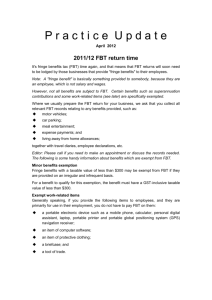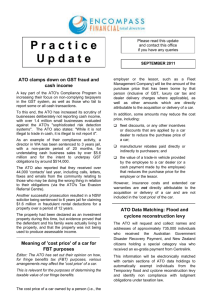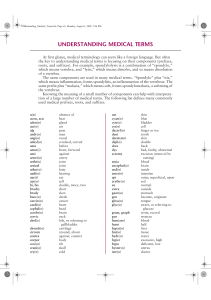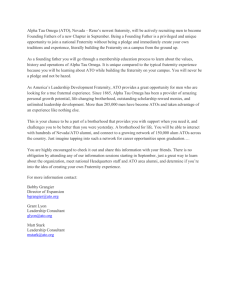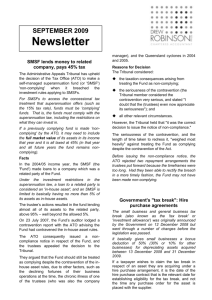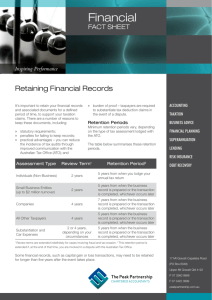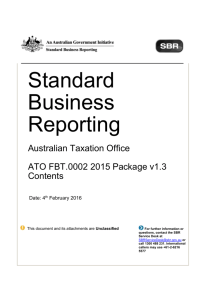aug2006_monthly_newsletter
advertisement
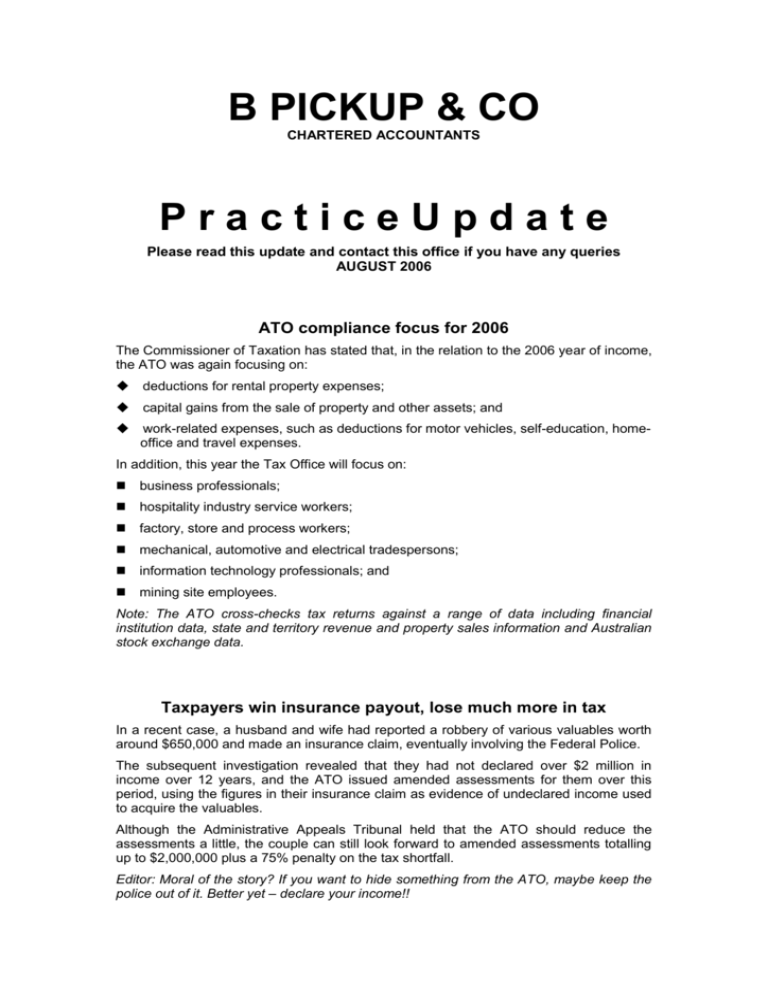
B PICKUP & CO CHARTERED ACCOUNTANTS PracticeUpdate Please read this update and contact this office if you have any queries AUGUST 2006 ATO compliance focus for 2006 The Commissioner of Taxation has stated that, in the relation to the 2006 year of income, the ATO was again focusing on: deductions for rental property expenses; capital gains from the sale of property and other assets; and work-related expenses, such as deductions for motor vehicles, self-education, homeoffice and travel expenses. In addition, this year the Tax Office will focus on: business professionals; hospitality industry service workers; factory, store and process workers; mechanical, automotive and electrical tradespersons; information technology professionals; and mining site employees. Note: The ATO cross-checks tax returns against a range of data including financial institution data, state and territory revenue and property sales information and Australian stock exchange data. Taxpayers win insurance payout, lose much more in tax In a recent case, a husband and wife had reported a robbery of various valuables worth around $650,000 and made an insurance claim, eventually involving the Federal Police. The subsequent investigation revealed that they had not declared over $2 million in income over 12 years, and the ATO issued amended assessments for them over this period, using the figures in their insurance claim as evidence of undeclared income used to acquire the valuables. Although the Administrative Appeals Tribunal held that the ATO should reduce the assessments a little, the couple can still look forward to amended assessments totalling up to $2,000,000 plus a 75% penalty on the tax shortfall. Editor: Moral of the story? If you want to hide something from the ATO, maybe keep the police out of it. Better yet – declare your income!! New FBT gross-up rates As a result of the reduction in the FBT rate from 48.5% to 46.5% as from 1 April 2006, the Tax Office (ATO) has now released new gross-up rates for calculating the grossed-up value of fringe benefits provided to employees. Type 1 benefits: 2.0647 (previously 2.1292) Type 2 benefits: 1.8692 (previously 1.9417) Editor: The Type 1 gross-up rate is used where the benefit provider is entitled to a GST credit in respect of the provision of a benefit. The Type 2 gross-up rate is used if the benefit provider is not entitled to claim GST credits. Note that only the Type 2 gross-up rate is used for reporting on employee’s payment summaries, regardless of whether the benefits provided are Type 1 or Type 2 benefits. FBT on accommodation for accompanying spouse The ATO has accepted that, where an employee travels on business and has a spouse accompany him/her, there will only be FBT on the additional cost of any accommodation for the spouse. Depending on the circumstances, the 'otherwise deductible' rule should operate so that there is no FBT on the employee’s accommodation costs (because the employee would otherwise be able to claim a deduction on his or her portion). Example The cost of accommodation for the employee only is $100, but the cost including the spouse as well is $120. As the extra $20 is an additional cost for the spouse over and above the cost that the employee would otherwise incur, the ATO agrees that the $20 would generally be a taxable fringe benefit amount. Example The cost of accommodation for the employee only is $100 and there is no additional cost for the accompanying spouse. Where there is no additional cost for the spouse as the room rate covers both single and dual occupancy, the ATO has agreed that there would generally not be a taxable fringe benefit in relation to the spouse. Editor: Unfortunately, the ATO has also advised that the cost of a travel insurance policy, paid for by an employer on behalf of an employee when the employee is travelling on business, is a private expense, and therefore subject to FBT. Car depreciation limit The car limit for the 2006/07 financial year is $57,009 (the same as that which applied in the 2005/06 financial year). The car limit of $57,009 is used to calculate depreciation deductions under the income tax law. Editor: Note that this amount (i.e., $57,009) is also used to determine the luxury car tax threshold. Costs of hiring furniture and ornaments included in cost base The ATO has recently confirmed that where a taxpayer sells a rental property, they can include the costs of hiring furniture and ornaments used in marketing the property as part of the cost base of the property, when calculating Capital Gains Tax. Hiring furniture and ornaments can be part of a marketing strategy to sell a property by displaying the saleable qualities of the property to greatest advantage. For example, furniture can be used to demonstrate the good qualities of the property (such as the size of the rooms) or to show that the less-desirable qualities of the property can be managed in a practical or pleasing manner. Although there has been doubt whether the hiring of furniture constituted ‘costs of advertising to find a buyer’, the ATO accepts that it is now arguable that the costs of hiring the furniture and ornaments can be included as part of the cost base of a property where the purpose of the expenditure is to find a buyer by demonstrating, displaying, exhibiting or featuring the saleable qualities of the property. Editor: Not all costs associated with selling an asset can be included in the cost base – the Tax Act basically sets out a list of what can be included. Benchmark interest rate for Div 7A The benchmark interest rate for the income year commencing 1 July 2006 is 7.55% p.a. (up from 7.30% p.a. for the 2005/06 income year). It is generally used to determine if a loan made by a private company to a shareholder in the 2006 income year is deemed to be a dividend (although certain loans from trusts can also be deemed 'dividends'). Such a loan can be deemed to be a dividend if there is no written loan agreement between the company and shareholder which has interest calculated at the benchmark interest rate or higher. The benchmark interest rate is also used to calculate the amount of the minimum yearly repayment on such a loan for the 2007 income year. Editor: If your company's accounts include such loans to its shareholders and we haven't discussed this already, please contact this office. Please Note: Many of the comments in this publication are general in nature and anyone intending to apply the information to practical circumstances should seek professional advice to independently verify their interpretation and the information's applicability to their particular circumstances.
